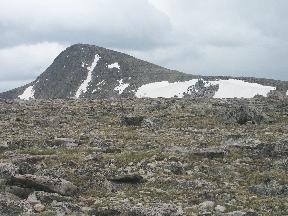



Three of us, J.C., Jack, and I, traveled to Colorado hoping to climb Longs Peak. I had done a lot of small hikes in RMNP, but no big summits. Jack had climbed some high volcanos in Mexico. Jack's description of high-altitude mountaineering was: "First you feel so bad that you're afraid you're going to die. Then you feel so bad that you're afraid you're not going to die. Then you get back home and tell everybody how great it was." J.C. had not done any mountaineering; he was Jack's and my boss.
| When we arrived in Colorado, there was lots of snow on Longs, and all routes were considered technical. In those days, the standard route up Longs was the cable route up the north face. J.C. wanted to rent ice axes and ropes and go up the north face route. However, an uncontrolled slide on the north face sends the climber over the east face for his final flight; given that only Jack had any snow and ice climbing experience, I refused to go on this route. We decided to climb Flattop, Hallett, and Otis instead; it wasn't Longs, but at least it was three summits. |  |
| We set off and climbed Flattop and Hallett. On the top of Hallett, we were joined by another party of climbers and by two rangers who were climbing the same peaks and replacing the climbing registers. The rangers also carried two-way radios, not so common in those days. As we talked on Hallett's summit, pikas scampered among the rocks where we sat. At one point, a pika walked up and bit one of the rangers on the butt -- perhaps expressing its dissatisfaction with the Park management. The ranger jumped up, not really hurt, but definitely surprised. With that, the rangers set off, moving much faster than we did. |  |
| We climbed Otis Peak and then went down the Andrews Glacier. The glacier extended halfway across and into the small lake called Andrews Tarn; it looked like one could get out of the tarn if one slid into it, but it certainly would be a cold bath. We took care not to slip. |  |
| Upon reaching Andrews Tarn it looked like that was the last of the snow. We cleaned the snow out of our boots, only to find more snow just below the tarn. There was a snow shelf that started off flat, but became steeper and steeper like the side of a barrel; we couldn't see the bottom. A set of footprints led down the snow. J.C. said, "Look, footprints! Come on, guys, this must be the way!" Jack said, "Yeah, and we'll find the body of the person who made those footprints down at the bottom." J.C. followed the footprints, while Jack and I looked for a safer way down. |  |
We moved down to where the rangers and the victim were. On the gently sloping snowfield, I discovered that my size-13 boots were big enough for skiing, so I was skiing down the snowfield. One of the rangers, fearing I might crash into the rocks at the bottom of the snowfield, jumped up to tackle me, but I managed to stop before I got to him.
There wasn't anything we could do to help, so we proceeded on down the trail. On the way down, we passed a dozen rangers coming up, some bringing a metal litter basket supported by a single bicycle wheel on the bottom.
A few lessons learned: